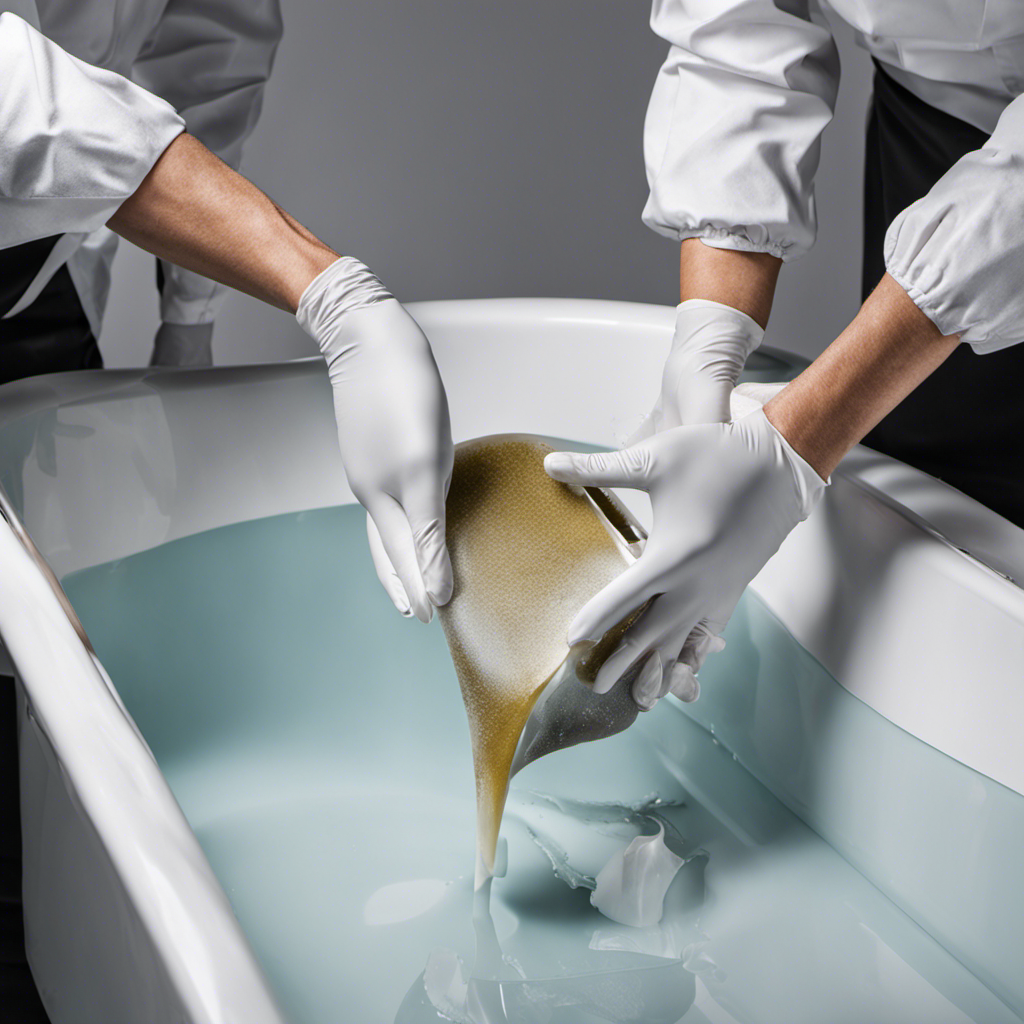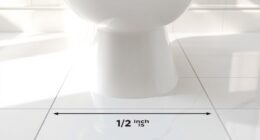Are you tired of battling the relentless invasion of bathtub mold? Don’t despair, for we have the ultimate solution to reclaim your pristine bathroom!
In this comprehensive guide, we will walk you through the step-by-step process of removing stubborn mold from your bathtub. Armed with the right tools and supplies, you’ll be able to banish this unwelcome guest once and for all.
Say goodbye to unsightly mold and hello to a squeaky clean, mold-free bathing experience!
Key Takeaways
- Excessive moisture is the main cause of bathroom mold.
- Proper ventilation and regular cleaning can help prevent mold growth.
- Identifying and assessing the severity of the mold infestation is important for effective removal.
- Using the right tools and supplies, such as protective gear and mold-specific cleaners, is necessary for safe and efficient mold removal.
Understanding the Causes of Bathtub Mold
To understand why bathtub mold keeps coming back, you need to know the common causes. The most common cause of bathroom mold is excessive moisture. Bathrooms are naturally humid environments, and when combined with poor ventilation, it creates the perfect breeding ground for mold. Leaky pipes, faucets, or fixtures can also contribute to moisture buildup, leading to mold growth. Additionally, lack of proper cleaning and maintenance can allow mold spores to settle and thrive on the surfaces of your bathtub.
Preventing bathtub mold requires a proactive approach. Ensure that your bathroom is well-ventilated by using exhaust fans or opening windows after showering. Fix any leaks promptly and regularly inspect your bathroom for any signs of water damage. Regularly clean your bathtub with a mold-killing cleaner and scrub away any visible mold. Remember, bathtub mold can have negative impacts on your health, such as respiratory issues, allergies, and skin irritations.
Identifying and Assessing the Mold Infestation
Take a close look at the affected areas to determine the extent of the mold infestation. Assessing severity is crucial in order to effectively remove bathtub mold.
Start by examining the surfaces surrounding the bathtub, including the grout lines, caulk, and any visible mold growth. Look for discoloration, musty odors, or any signs of water damage. Pay attention to areas that are frequently damp or poorly ventilated, as these are prime breeding grounds for mold.
It’s important to understand the health risks associated with mold exposure, as certain individuals may be more susceptible to respiratory issues or allergic reactions. By properly assessing the severity of the mold infestation, you can take the necessary steps to ensure a thorough and safe removal process.
As you move forward, it’s crucial to choose the right tools and supplies for mold removal.
Choosing the Right Tools and Supplies for Mold Removal
When choosing the right tools and supplies for mold removal, it’s important to consider the specific needs of your situation. Different cleaning techniques and effective products can help you effectively tackle bathtub mold.
Start by wearing protective gear such as gloves, goggles, and a mask to ensure your safety.
For cleaning, a scrub brush or sponge can be used to physically remove the mold. Combine a mixture of water and detergent or a mold-specific cleaner to effectively clean the affected areas.
Additionally, a solution of equal parts water and white vinegar can help kill and prevent future mold growth.
To ensure thorough drying, use a fan or dehumidifier.
Step-by-Step Guide to Removing Bathtub Mold
Start by assessing the extent of the mold growth in your bathtub to determine the necessary steps for removal. Bathtub mold can be a common problem in bathrooms due to the moisture-rich environment. To prevent mold from growing in your bathtub, it is important to keep the area clean and dry. Regularly scrubbing the bathtub with a mixture of bleach and water can help prevent mold growth. However, if you already have mold in your bathtub, here are some effective mold removal techniques you can follow:
| Steps for Removing Bathtub Mold |
|---|
| 1. Put on protective gloves and a face mask. |
| 2. Mix equal parts bleach and water in a spray bottle. |
| 3. Spray the moldy areas and let the solution sit for 10-15 minutes. |
| 4. Scrub the moldy areas with a brush or sponge. |
Preventing Future Mold Growth in the Bathtub
To prevent future growth, it’s important to regularly clean and dry the bathtub area. Moisture is the main culprit behind mold growth, so keeping the bathtub dry is crucial.
After each use, make sure to wipe down the tub with a towel to remove any excess water. Additionally, consider using natural cleaning methods to keep the area clean and mold-free.
Vinegar is a great natural cleaner that can effectively remove mold and prevent its regrowth. Mix equal parts vinegar and water in a spray bottle and spray the solution onto the bathtub surface. Let it sit for a few minutes before scrubbing with a brush and rinsing thoroughly.
Regularly cleaning and using natural cleaning methods will help prevent moisture and mold from taking hold in your bathtub area.
Frequently Asked Questions
How Long Does It Take for Bathtub Mold to Grow?
Bathtub mold can grow within a few days if the conditions are right. To prevent bathtub mold, keep the area dry and well-ventilated. Look out for signs like black spots or a musty odor.
Is Bathtub Mold Harmful to Health?
Bathtub mold can pose potential health risks, such as respiratory issues and allergic reactions. To eliminate it, there are effective mold removal methods available. It’s important to address the issue promptly to ensure a healthy living environment.
Can I Use Regular Household Cleaners to Remove Bathtub Mold?
Yes, you can use regular household cleaners to remove bathtub mold. Bleach is an effective option for killing mold, but if you prefer natural remedies, vinegar or hydrogen peroxide can also do the job.
Can I Prevent Bathtub Mold by Using a Shower Curtain?
To prevent bathtub mold, using a shower curtain is a good start, but there are other alternatives you can explore. By keeping the bathroom well-ventilated, using mold-resistant materials, and cleaning regularly, you can effectively prevent mold growth.
How Often Should I Check for Bathtub Mold?
To prevent bathtub mold, you should regularly check for signs of mold growth. This includes looking for dark spots, musty odors, or a slimy film. Check at least once a month to catch any mold early.
Conclusion
In conclusion, removing bathtub mold can be a daunting task, but it is manageable with the right tools and supplies. By following a step-by-step guide and taking preventive measures, you can ensure a mold-free bathtub.
Did you know that according to a study conducted by the Environmental Protection Agency, around 50% of homes have visible mold growth? This statistic highlights the importance of addressing mold infestations promptly to maintain a clean and healthy living environment.
So, don’t let mold take over your bathtub, take action today!










